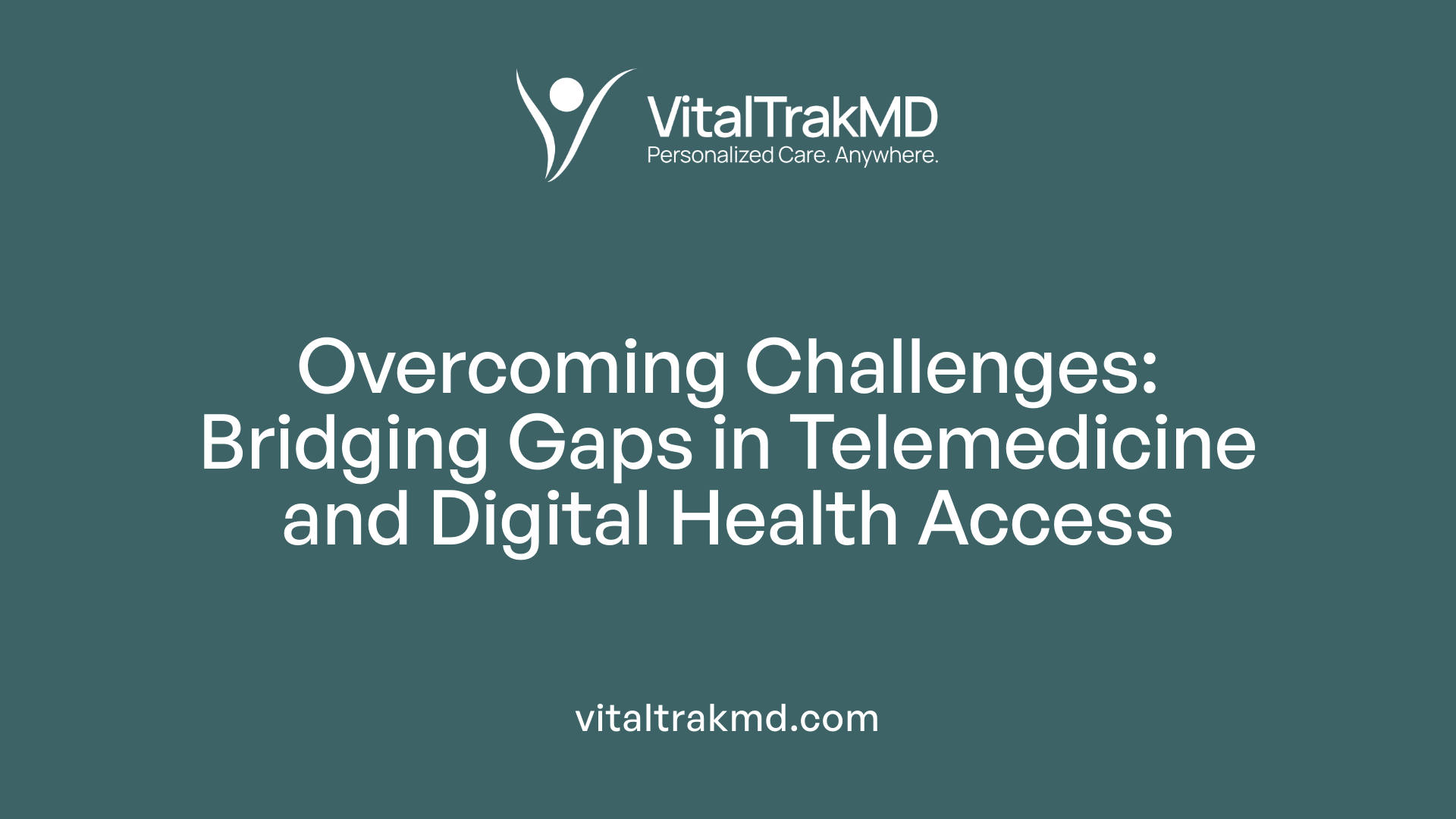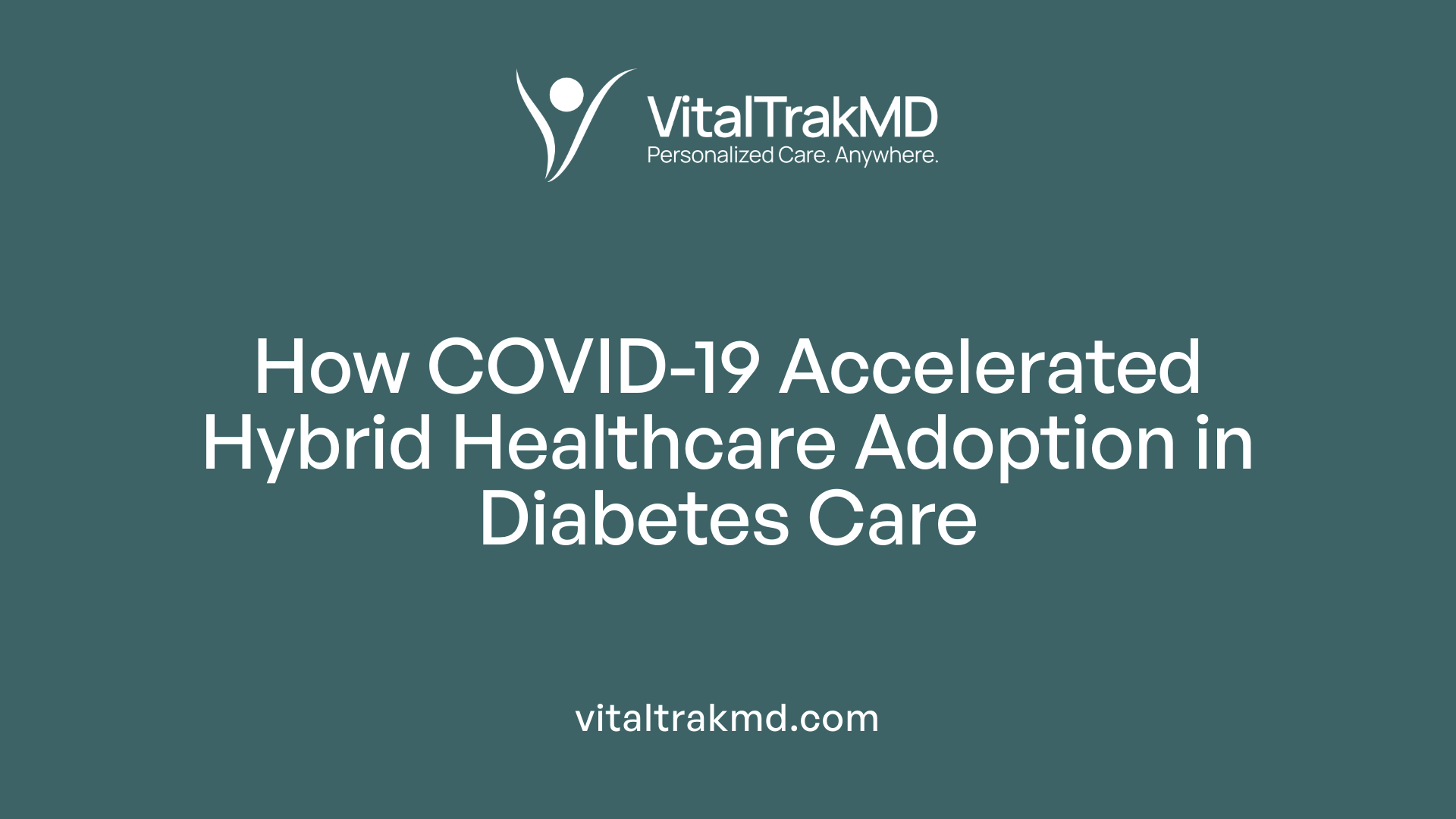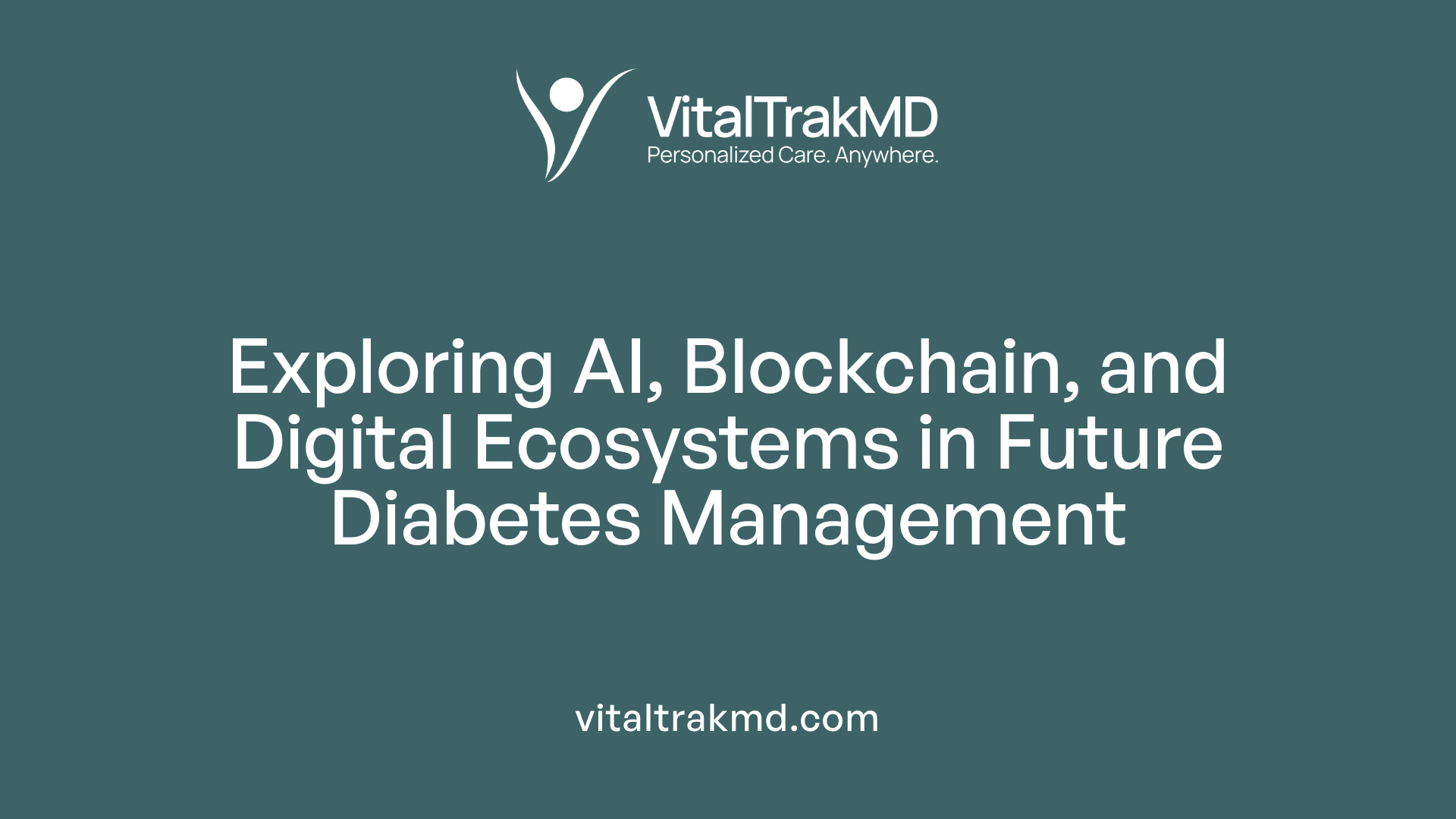Managing Diabetes Remotely Using Hybrid Healthcare Approaches

Transforming Diabetes Management in the Digital Age
The landscape of diabetes management is evolving rapidly, driven by technological advancements and the necessity for flexible care models. Hybrid healthcare approaches integrate both telemedicine and in-person care to optimize outcomes, address barriers, and improve patient quality of life. This article explores how these models are being implemented, their benefits, effectiveness, and the innovative tools that support remote diabetes management.
The Concept of Hybrid Healthcare in Diabetes Care
What is a hybrid healthcare approach, and how does it integrate telemedicine and in-person care for diabetes management?
A hybrid healthcare model combines traditional in-person visits with telemedicine services to offer comprehensive and flexible diabetes management. This approach uses digital technologies such as secure video calls, remote glucose monitoring devices, and online educational resources to maintain continuous patient-provider engagement.
Initially, patients may have face-to-face consultations to establish care plans, undergo assessments, and receive personalized education. After this, regular follow-ups, check-ins, and educational support can be carried out remotely, allowing patients to share real-time health data, such as blood glucose levels, through digital platforms.
Telemedicine components include virtual consultations, remote monitoring via apps and wearable devices, and digital communication tools, all designed to reduce the need for frequent physical visits. In-person visits are maintained when more comprehensive examinations or procedures are necessary, ensuring thorough care.
This integration allows for tailored care strategies, increased accessibility especially for patients in remote or underserved areas, and enhanced patient engagement. It also enables healthcare providers to respond swiftly to changes in health status, adjust medications, and offer behavioral support remotely.
During the COVID-19 pandemic, the adoption of hybrid models surged significantly, proving their effectiveness in maintaining glycemic control and improving patient satisfaction. The use of such models leverages established technology platforms and emphasizes strategic implementation to maximize benefits.
Ultimately, hybrid healthcare models represent a balanced approach. They blend the personalized attention of in-person care with the convenience, efficiency, and continuous access enabled by telemedicine, leading to better health outcomes and optimized resource use in diabetes management.
Digital Technologies Transforming Diabetes Management
What technologies and digital health tools are used in remote diabetes management?
Remote management of diabetes has been revolutionized by a suite of advanced digital tools and technologies that facilitate continuous monitoring, personalized care, and effective communication between patients and healthcare providers.
One of the most prominent tools is the continuous glucose monitor (CGM). These devices, such as Dexcom’s G6 and Abbott’s FreeStyle Libre, provide real-time glucose data, enabling more precise insulin therapy adjustments. CGMs deliver vital information that helps patients and providers optimize glycemic control, reduce hypoglycemia risk, and make timely treatment decisions.
Remote patient monitoring (RPM) systems further enhance diabetes management. RPM platforms like Glooko and Livongo collect and transmit blood glucose readings, medication adherence data, and lifestyle information. These systems enable healthcare teams to review patient data remotely, offer tailored interventions, and track long-term health outcomes.
Mobile health (mHealth) applications and digital platforms play a crucial role in patient self-management. Apps such as My Diabetes Team, One Drop, and BlueLoop allow users to log and analyze blood glucose levels, medication schedules, diet, and physical activity. Many of these apps are integrated with connected devices, providing seamless data sharing and real-time feedback. They also offer educational resources, behavioral coaching, and reminders to support lifestyle modifications.
Telemedicine encompasses various delivery modalities, including live video consultations (synchronous care), where patients discuss their condition directly with healthcare providers, and asynchronous communication, where data is shared electronically for review and follow-up. These approaches enable ongoing remote interactions, medication adjustments, and educational support.
Additionally, teleretinal screening technologies aid in early detection of diabetic retinopathy without the need for in-person visits, which is crucial for preventing vision loss. Digital fundus imaging can be performed remotely, with images evaluated by specialists, increasing screening adherence especially in underserved populations.
Overall, these digital health tools collectively support comprehensive, accessible, and personalized diabetes care. They help improve glycemic control, reduce complications, and promote patient engagement outside traditional healthcare settings. Their integration into routine management signifies a significant step toward more effective, patient-centered diabetes treatment through technological innovation.
Effectiveness of Hybrid Models in Glycemic Control
How effective are remote and hybrid diabetes management strategies in controlling blood glucose levels?
Research during the COVID-19 pandemic and beyond indicates that hybrid models combining in-person care with telemedicine are highly effective in managing uncontrolled type 2 diabetes. A notable study involving 181 patients with HbA1c levels ≥9% demonstrated a significant reduction in HbA1c from 10.47% to 7.87% after an average of four months of integrating telemedicine follow-ups with initial in-person treatment. Similar results were observed across multiple centers, with average HbA1c decreases of over 2 percentage points, affirming the potency of combined care approaches.
In addition, comprehensive programs like the GluCare model in the United Arab Emirates, which incorporate digital health tools, real-time data tracking, personalized coaching, and remote continuous data monitoring (RCDM), have shown further metabolic improvements. Patients adhering to these systems experienced HbA1c reductions from 7.76% to 6.96%, alongside weight loss and improved lipid profiles. These outcomes underscore that hybrid strategies not only help achieve glycemic targets but also support broader metabolic health.
When comparing these approaches to traditional care, results reveal that hybrid models often outperform standard clinic visits alone. The frequent engagement, facilitated by technology, fosters better medication adherence, timely dose adjustments, and behavioral change. These advantages are especially impactful in managing complex patients or those with comorbidities, who benefit from continuous, personalized care.
Furthermore, the use of advanced digital tools such as real-time continuous glucose monitoring (rtCGM), mobile health apps, and remote data sharing has been associated with improved key metabolic parameters. For instance, patients using remote glucose monitoring systems have demonstrated lower HbA1c levels, decreased weight, and enhanced lipid profiles while maintaining safety, including no increase in hypoglycemia.
Overall, the accumulated evidence confirms that hybrid remote-in-person models significantly improve blood glucose control, reduce complication risks, and support sustainable diabetes management. They represent a promising evolution in care delivery, combining technological innovation with clinical expertise to optimize health outcomes.
Role of Remote Patient Monitoring (RPM) and Telehealth
How does remote patient monitoring and telehealth contribute to better blood glucose control?
Remote patient monitoring (RPM) and telehealth play a crucial role in managing blood glucose levels effectively. They enable continuous, real-time sharing of vital health data from patients to healthcare providers through digital tools such as glucose monitors, continuous glucose monitoring (CGM) devices, and smartphone applications. This constant data flow allows for timely adjustments in treatment plans and interventions.
By facilitating ongoing communication, RPM and telehealth help in early detection of blood sugar fluctuations, which can be promptly addressed. Patients benefit from personalized feedback, coaching, and education, which reinforce self-management behaviors. Structured self-monitoring of blood glucose, supported by these digital platforms, encourages better adherence and behavioral change.
Studies have shown that when combined with goal setting, medication titration, and provider feedback, telehealth interventions can lead to significant reductions in HbA1c levels. Patients with higher initial HbA1c tend to experience more substantial improvements. These technologies foster more precise, patient-centered, and timely care, ultimately improving glycemic outcomes.
Patient engagement and self-management
Investing in digital health tools increases patient involvement in care. They promote active self-monitoring and understanding of diabetes control, which can improve motivation and adherence to treatment. Features like visual data dashboards, reminders, and educational content empower patients to make informed decisions daily.
Furthermore, by providing easy access to healthcare providers through virtual visits, patients can clarify concerns, receive support, and adjust behaviors without the need for frequent in-person visits. This ongoing engagement reinforces healthy habits and enhances the overall quality of diabetes management.
Clinical decision-making improvements
The integration of real-time data from RPM devices allows healthcare providers to make more informed clinical decisions. Remote access to blood glucose trends helps in timely medication adjustments, including insulin titration, and ensures treatment aligns with patients’ daily variations.
Providers can review longitudinal data, identify patterns, and address issues like hypoglycemia or hyperglycemia earlier. The ability to swiftly respond to data insights improves patient safety and treatment efficacy.
Studies demonstrating benefits in glycemic control
Research consistently supports the efficacy of RPM and telehealth interventions. For instance, patients adherent to remote monitoring programs demonstrated HbA1c reductions from 7.76% to 6.96%, along with weight loss and lipid profile improvements.
A systematic review of various telehealth studies revealed significant improvements in glycemic control, with reductions in HbA1c and other markers, particularly in veterans and populations in the USA. Continuous glucose monitoring combined with telehealth support has also proven safe and effective, with no increase in hypoglycemia events and improved time-in-range metrics.
These findings underscore that integrating digital health technologies with traditional care enhances diabetes management outcomes, especially when patients actively participate and adhere to monitoring protocols.
Implementation Strategies and Practical Considerations
What are some implementation strategies and practical considerations for adopting hybrid healthcare in diabetes care?
Implementing hybrid healthcare models for diabetes involves coordinating multiple components to optimize patient outcomes. One foundational step is staff training; healthcare providers need to learn how to effectively incorporate digital health tools such as telemedicine platforms, remote glucose monitoring devices, and electronic health records into routine care. This ensures smooth integration and maximizes the benefits of technology.
Patient education is equally important. Patients should be guided on using digital tools, understanding their data, and engaging actively in their care through telehealth consultations and remote monitoring. Tailoring educational content to various literacy levels and cultural backgrounds enhances adherence and engagement.
Policy implications play a significant role. Clear reimbursement frameworks, licensing flexibility, and telehealth policies that support sustainable operations are crucial. Reimbursement parity for virtual visits encourages clinics to maintain hybrid models without financial strain.
Technology integration and interoperability are practical challenges. Ensuring that different devices, software, and health records communicate seamlessly reduces errors and streamlines workflows. Investing in compatible systems and data security measures safeguards patient information.
Community engagement and efforts to address health equity are vital. Outreach programs, peer support groups, and partnerships with local organizations can expand access to underserved groups, including those with limited internet access or lower health literacy.
In addition, ongoing evaluation using frameworks such as RE-AIM (Reach, Effectiveness, Adoption, Implementation, Maintenance) helps identify areas for improvement and sustain quality.
Addressing systemic barriers—such as resource limitations, provider shortages, and technological infrastructure gaps—requires collaborative efforts among policymakers, healthcare organizations, and communities.
Finally, fostering innovation through continuous digital health education, policy support, and stakeholder collaboration ensures that hybrid models remain adaptable, effective, and scalable. These comprehensive strategies are essential for translating the promise of hybrid healthcare into tangible improvements in diabetes management.
Challenges and Barriers in Telemedicine Integration

What challenges exist in integrating telemedicine into diabetes management, and how can they be addressed?
The adoption of telemedicine in diabetes care has brought many benefits, but it also encounters several hurdles that must be overcome to ensure equitable and effective management.
One of the primary issues is technological disparities. Not all patients have equal access to reliable internet or appropriate devices. Older adults, individuals from minority communities, and those with lower educational backgrounds often face difficulties due to limited digital literacy and socioeconomic barriers. These factors can prevent some patients from fully engaging with remote health services.
Device availability and connectivity issues further complicate remote monitoring. For example, unstable broadband or inconsistent data sharing from glucose meters and other digital tools can impair healthcare providers’ ability to make timely decisions. Standardizing the integration of remote data into electronic health records is essential for seamless care.
Clinical assessments pose another challenge, as remote care cannot fully replace physical examinations, point-of-care testing, or physical distancing constraints. This limitation necessitates a hybrid model that combines telehealth with in-person visits, ensuring comprehensive evaluation.
Addressing these challenges involves multiple strategies. Expanding internet coverage and providing affordable access to digital devices can bridge the digital divide. Enhancing digital literacy through patient education programs will empower users to navigate telehealth platforms confidently.
Providers need robust infrastructure to incorporate real-time monitoring data into clinical workflows effectively. Developing standardized guidelines for remote assessment and care delivery can further harmonize practices across different care centers.
Ultimately, blending telehealth with traditional face-to-face care can mitigate limitations, ensuring all patient populations receive high-quality, personalized diabetes management. Policy support, technological innovation, and community outreach are vital in overcoming these barriers and maximizing the potential of telemedicine in diabetes care.
| Challenge | Impact | Possible Solutions | Additional Notes |
|---|---|---|---|
| Digital divide | Limits access for vulnerable groups | Expand internet access, provide devices | Critical for equitable care |
| Digital literacy | Hinders effective use of telehealth tools | Patient education, tech support | Improves engagement |
| Data interoperability | Impacts data sharing and decision-making | Develop standardized data protocols | Needed for seamless integration |
| Clinical assessment limitations | Incomplete care assessments | Hybrid in-person and virtual visits | Ensures comprehensive care |
| Infrastructure variability | Affects care consistency | Policy and infrastructure investment | Ensures quality and equity |
Understanding and addressing these barriers is essential for the sustainable integration of telemedicine into routine diabetes care, especially as technology continues to evolve and expand.
Adapting Hybrid Healthcare During Pandemic Conditions

How did the COVID-19 pandemic accelerate the adoption of hybrid healthcare models for diabetes management?
The COVID-19 pandemic prompted a rapid shift in healthcare delivery methods worldwide, especially for chronic disease management like diabetes. Social distancing measures, lockdowns, and restrictions on in-person visits made traditional face-to-face care challenging. As a result, healthcare systems quickly adopted hybrid models combining in-person visits with telemedicine, digital health tools, and remote monitoring.
This transition allowed healthcare providers to maintain continuous patient engagement, monitor blood glucose levels remotely, adjust medications, and offer education without the need for regular physical appointments. Technologies such as real-time glucose monitors, smartphone apps, and virtual consultations became integral to this approach, enabling patients to receive ongoing care despite physical barriers.
How did hybrid care ensure continuity of diabetes treatment in restricted settings?
Hybrid healthcare models ensured ongoing diabetes management by integrating remote data sharing and virtual support. Patients could continuously track blood glucose, sleep, diet, and physical activity through digital devices, sharing real-time data with their care teams. Virtual consultations facilitated medication titration, behavioral counseling, and educational sessions.
Post-discharge support via telehealth also helped reduce the risk of readmission and managed complications proactively. These measures preserved the quality of care during periods when in-person visits were limited, especially critical for uncontrolled diabetes (HbA1c ≥9%) and pre-existing complications.
What lessons have been learned from the implementation of hybrid models, and how can they inform future healthcare preparedness?
The experience with hybrid models during the pandemic has underscored the importance of flexibility, technological infrastructure, and patient engagement. Key lessons include the necessity of robust digital platforms that facilitate secure data sharing and real-time communication.
Healthcare systems learned that provider training in digital tools, policy support for reimbursement, and addressing patient barriers like digital literacy are vital. Ensuring equity remains a challenge, with vulnerable populations often facing technological and socioeconomic barriers.
Future preparedness involves developing resilient systems capable of scaling rapidly during crises, integrating remote monitoring with traditional care, and fostering collaborations across sectors. Building an adaptable, hybrid healthcare framework can improve responsiveness, reduce disparities, and sustain high-quality care across various conditions.
How have policy and infrastructure adaptations supported the growth of hybrid models during COVID-19?
Policy changes during the pandemic played a crucial role in enabling hybrid healthcare. Reimbursement policies that recognized telehealth services as equivalent to in-person care motivated providers to adopt these approaches.
Legislative flexibilities around licensing, data security, and cross-state practice expanded access and provider participation. Infrastructure investments in broadband internet, digital health platforms, and device distribution helped address accessibility issues.
Organizations like LifeBridge Health’s Center for Virtual Care and regional healthcare systems implemented remote patient monitoring and teleconsultations, demonstrating effective models of hybrid care.
In conclusion, the COVID-19 pandemic served as a catalyst for transforming diabetes care through hybrid healthcare models. Rapid adoption, focused on maintaining treatment continuity and patient safety, has created a blueprint for future resilience and innovation in healthcare delivery.
| Aspect | Details | Additional Notes |
|---|---|---|
| Accelerators | Policy support, technological advancements, pandemic urgency | Supported scalability and adoption |
| Challenges | Digital divide, data security, provider training | Need for ongoing solutions |
| Future focus | Integration, equity, preparedness | Building resilient systems |
Impact of Hybrid Care on Access and Long-term Outcomes
What impact do hybrid healthcare approaches have on patient access and chronic disease management?
Hybrid healthcare models, combining in-person visits with telemedicine and digital health tools, markedly enhance access to diabetes care. They overcome common barriers such as geographic distance, transportation issues, and scheduling conflicts that often hinder regular healthcare consultations.
This approach is particularly beneficial for rural and underserved populations, who historically face difficulty accessing specialist healthcare services. By utilizing telemedicine platforms, remote monitoring, and digital data sharing, patients can receive continuous support and personalized interventions without frequent travel.
The increased contact frequency and real-time data sharing facilitate better adherence to treatment plans and enable timely adjustments. This proactive engagement results in improved glycemic control, reduced risk of complications, and more consistent disease management.
Over time, these models have the potential to narrow healthcare disparities by providing equitable access regardless of location or socioeconomic status. They promote a more inclusive healthcare system where everyone receives comprehensive and ongoing diabetes care.
Long-term benefits extend beyond clinical improvements. Patients often experience enhanced quality of life due to better disease management, fewer hospitalizations, and less burden of travel and wait times.
Patient satisfaction tends to be high with hybrid approaches, driven by the convenience of remote consultations, cost savings from fewer in-person visits, and a greater sense of involvement in health management.
Overall, hybrid healthcare models transform the landscape of chronic disease management by promoting accessibility, equity, and sustained health improvements.
Case Studies and Real-world Applications

Are there case studies or real-world examples demonstrating the success of hybrid healthcare models in diabetes management?
Yes, there are several compelling examples that illustrate the effectiveness of hybrid care models for diabetes. One prominent case comes from the United Arab Emirates, where a comprehensive hybrid program, known as the GluCare model, integrated remote continuous data monitoring (RCDM) with traditional in-clinic visits. Over a minimum of 12 months, patients participating in this program experienced significant health improvements. Their HbA1c levels decreased from an average of 7.76% to 6.96%, accompanied by weight loss of approximately 4 kilograms, a reduction in waist circumference, and better lipid profiles. These outcomes demonstrate how combining digital health tools with face-to-face care can enhance glycemic control and overall health.
Another example is from the United States, where a retrospective study focused on older adults with type 1 diabetes. The hybrid care approach involved increasing the frequency of diabetes-related visits—up from 4.2 to over 6 visits annually—without worsening glycemic control, which remained around 7.2-7.4%. Notably, among patients using continuous glucose monitors (CGMs), there was an improvement in time-in-range (70-180 mg/dL), increasing from 68% to 71%. Importantly, this model maintained safety, with no increase in hypoglycemia events.
The COVID-19 pandemic further accelerated the adoption of hybrid models worldwide. Many clinics transitioned rapidly to combine virtual consultations with in-person visits, ensuring patients continued to receive essential care. These adaptations helped maintain or even improve clinical outcomes, reduce hospitalizations, and increase patient satisfaction due to increased convenience and accessibility.
Overall, real-world applications underscore that hybrid healthcare models can deliver safer, more effective, and patient-centered diabetes management. They facilitate continuous monitoring, promote behavioral engagement, and allow healthcare providers to intervene proactively, demonstrating their vital role in modern chronic disease care.
Future Directions and Emerging Trends

What are some emerging trends and future directions in managing diabetes remotely using hybrid healthcare?
The management of diabetes is rapidly evolving with the integration of advanced digital technologies and personalized care strategies. One prominent trend is the incorporation of artificial intelligence (AI) and blockchain technology into hybrid healthcare models. AI algorithms can analyze extensive patient data—from glucose levels to behavioral patterns—to predict high-risk situations, optimize medication adjustments, and customize treatment plans. This enhances early intervention and improves overall disease control.
Blockchain technology is also gaining attention for its potential to securely store and share sensitive health information. It ensures data integrity, enhances privacy, and facilitates transparent, tamper-proof medical records, which are crucial for remote and decentralized care.
Another future direction involves developing comprehensive digital ecosystems that connect wearable devices, smartphone applications, and telemonitoring platforms. These ecosystems enable seamless, real-time data sharing, allowing healthcare providers to make timely decisions and adjustments. Wearables like continuous glucose monitors (CGMs) integrated with AI-powered analytics can provide predictive insights, fostering proactive management.
Scaling these hybrid models across various populations and healthcare settings is a priority to improve health equity and cost efficiency. Efforts focus on adapting technology interfaces for diverse patient groups, including older adults and underserved communities, ensuring accessibility and engagement.
Research priorities are shifting towards understanding long-term outcomes of hybrid care, automating insulin delivery systems, and improving user interfaces for better patient experience. Developing policies that support sustainable reimbursement, data security, and provider training is essential to widespread adoption.
In summary, embracing AI, blockchain, and integrated digital ecosystems within hybrid healthcare models promises a transformative impact on diabetes management. These innovations aim to make personalized, accessible, and efficient care a standard worldwide, ultimately reducing complications and enhancing quality of life for individuals with diabetes.
Harnessing Technology for Better Health Outcomes
The integration of digital health tools and hybrid healthcare models represents a major step forward in diabetes management. They enable personalized care, improve access, and foster patient engagement, ultimately leading to better metabolic control and quality of life. Continued innovation, policy support, and addressing existing barriers are vital for fully realizing their potential. As healthcare systems adapt and evolve, hybrid models will likely become the standard, offering sustainable, patient-centered solutions for managing diabetes effectively in the digital age.
References
- A Hybrid Model of In-Person and Telemedicine Diabetes Education ...
- Effectiveness of a hybrid technology enabled care model as ...
- A Hybrid Care Model to Manage Diabetes Mellitus in the United ...
- How the Hybrid Care Model is Transforming Patient Access
- Telemedicine for the Clinical Management of Diabetes
- Challenges and Opportunities in Using Telehealth for Diabetes Care
- Hybrid care model: Combining telemedicine and office visits for ...
Recent articles
Want to Feel Better and Live Healthier?
Join hundreds of patients taking control of their health with personalized care that fits their life – not the other way around.
Rated 4.8/5 by 32+ customers







